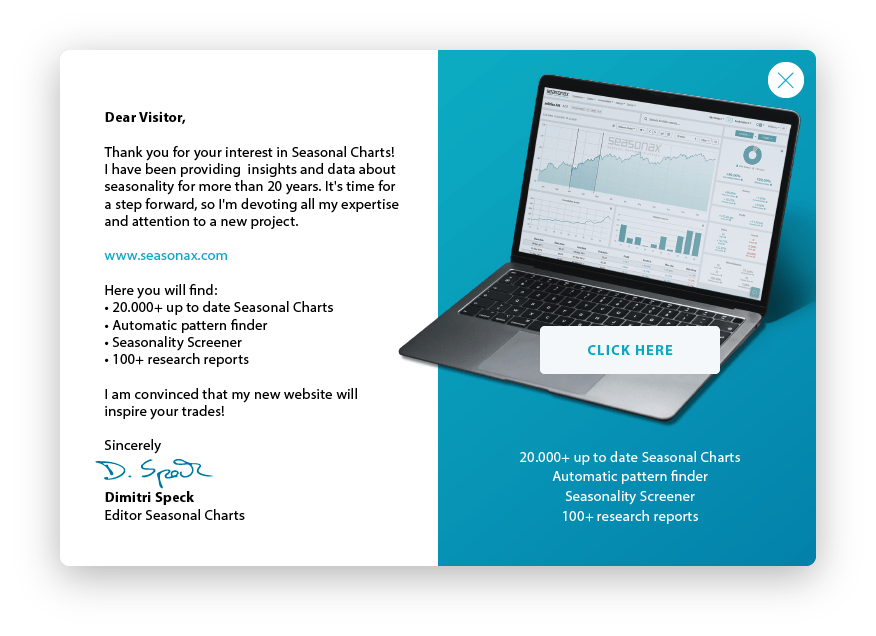Seasonal Trading Strategies
Seasonality is basically a technical signal generator with an essentially fundamental background. It can be characterized as a blend of both price and calendar elements. In a statistical sense, the calendar aspect delivers added benefit because as an external factor it is independent of standard indicators. It is similar with intermarket analysis or fundamental analysis. This added benefit is seasonality's main advantage (it does not correlate with other indicators). External signal generators do not have a virtual automatic loss-limiting function with individual signals, as is the case with trend following methods, which means for example that stop loss orders should be used. The disadvantages of seasonality include the fact that individual years can vary, that seasonality itself can change and that random events (e.g. extreme years) can look like seasonal patterns. It must be kept in mind that seasonality as such does not exist in one market; rather only individual seasonal patterns exist.
Because of its calendared nature, seasonality is really an intermediate-term signal generator. Nevertheless, it can also be used for short-term trading because the primary trend also influences the profitability of short term signals (this can for instance be utilized with the leverage-trading strategy). Long-term oriented investors can also utilize seasonality, namely for fine tuning entry (for example by shifting the planned buying of a stock from August to the more favorable November time frame).
Description: In seasonally unfavorable periods, investments are waived. This leads to fewer losses and a reduction in drawdowns. In the process the profit side is also reenforced.
Example: During the seasonally weak months of August through October equity investments are shunned. The following diagram clearly shows that in this way, during all market phases, each with varying points of entry, a significant out-performance was attained through the end of 1999. Thus, even this simple approach increased profits. This is even more remarkable considering that the strategy is defensive; after all, over a period of three months you are not even in the volatile equity market.
 |
|
Application: The filter method is very easy to apply. As trading technique it is actually a special variation of the following leverage technique.
Description: Depending on the seasonal cycle, an investment is either increased or scaled back.
Example: In November, when a favorable seasonal phase begins, 1200 shares of a stock are purchased instead of the previously planned 1000 shares. On the other hand in August, when a seasonally unfavorable period begins, 800 shares of a stock are purchased instead of the planned 1000 shares. This smoothes the earnings curve, reduces losses, and lifts profits.
Application: The leverage technique is easy to use.
Description: Out of a long list of signal generators of which seasonality is just one, a trading strategy is created with the help of a logical operation. The goal is the optimal combination of a series of signal generators, which are as non-correlated as possible.
Example: Each of he following six factors are assigned the value '1', if it typically favors a positive trend in the stock market: long-term interest rates, short-term interest rates, long-term market trend, short term market trend, inflation, seasonality. If the sum is greater than three, then a long position is opened.
Application: The application of the Complex technique for individual areas such as equities can still be described as easy. The professional development of a complex trading strategy requires about two to four man years.
Description: A position is opened in accordance with a single seasonal trend that has proven itself in the past.
Example: Purchase one Dax future on December 15 and sell it on January 6 of the following year with a stop loss (risk protection) 80 points below the entry price.
Application: Because of its sense of urgency this approach is highly favored among newcomers to seasonality, however it is only recommended for professional execution, because it requires strict risk limitation, diversification (distributing positions across many individual patterns and markets) and elaborate statistical analysis. The professional development of a trading strategy based on individual patterns requires about two to four man years. Preliminary work was done by MRCI and Jake Bernstein (see links).
Please read our disclaimer.
© 2001-2008 Dimitri Speck




